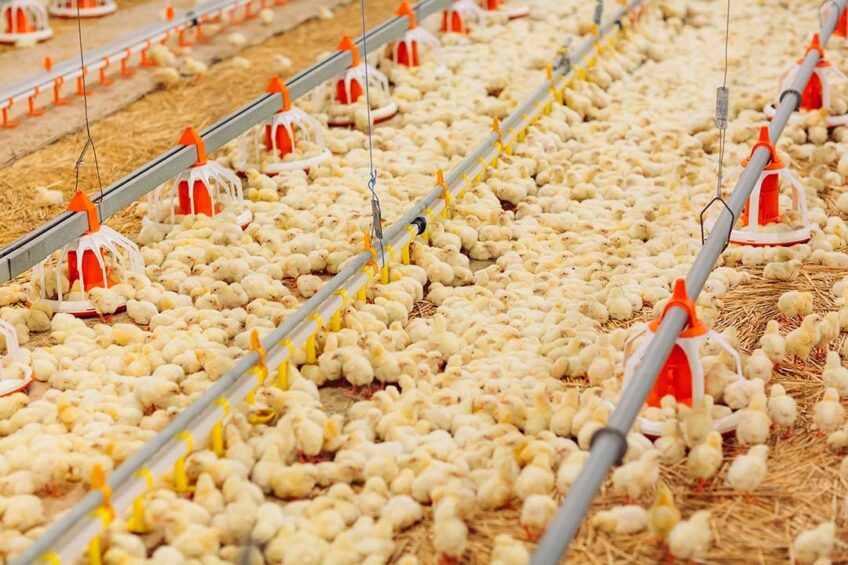Active walking in broiler chickens – a flagship for good welfare

Automated assessment of broiler chicken welfare poses particular problems due to the huge number of birds involved and the range of different welfare measures currently being proposed. What is active walking, and could this be a starting point for automated welfare recognition?
Smart technology is increasingly being used to monitor and manage the keeping of farm animals and has the potential to improve both efficiency and animal welfare. Use of smart technology is particularly advanced in the dairy sector, where automated monitoring has contributed to animal welfare by enabling each animal to have its own individualised diet and medical treatment.
Individual animal vs flock
In dairy farming, each animal contributes a significant proportion of the economic output of the whole herd, making it financially viable for the herd to be managed and monitored. But this is more difficult in the poultry sector due to the economic unit consisting of thousands – even millions – of chickens.
In the broiler sector it is common for 20,000 to 50,000 birds to be kept in one house, and there are usually several houses on one farm and up to 7 flock cycles a year. As a consequence, the economic value of each bird is small compared to the overall enterprise. As a result, management decisions such as when to apply medication change the light regime, diet or drinker height are taken not for the benefit of the individual bird for the average of the whole flock. Poultry producers specify welfare outcomes, such as hock burn and mortality not bird by bird but as a percentage outcome of the whole flock.
Professor Marian Dawkins from the Department of Biology at the University of Oxford argues that this raises a second problem as welfare should be an individual matter not a property of a flock or herd. “It is individual animals that suffer and feel pleasure or pain so flock level measures alone are not enough to guarantee good poultry welfare,” she said.
Smart tech
Dawkins says it is here that smart technology can make a revolutionary contribution to improving broiler chicken welfare: “Precision crop agriculture has already shown the advantages of applying treatments such as fertiliser or irrigation to specific parts of the field or even individual plants rather than treating the whole field as a single entity.
“Precision poultry farming similarly has the potential to give greater emphasis to the welfare of the individual bird than has so far been possible, for example, by alerting the farmer to the location of an injured or lame bird or to an area of the house where there is a potential problem such as smothering or over-crowding.
“Houses containing many thousands of birds would no longer have to be treated as a single unit but as flocks of many individuals, experiencing different conditions and having different welfare outcomes,” said Dawkins.
But at present, technology is not available to do this because separating one bird out of a flock of thousands of identical white broilers, that, unlike plants, are constantly moving, merging and dispersing in lighting that is often at a low level makes processing images very difficult. Sound and thermal imaging pose similar problems of distinguishing birds from the background and from each other.
Welfare measures
The third problem, argues Dawkins, is which welfare measure(s) to use. The 5 Freedoms and the 5 Domains have played an essential part in setting welfare goals that can be agreed by producers, scientists and the general public, but they are over-arching aspirations and not detailed instructions on how to welfare measure in practice.
For use on real farms, they need to be translated into actual measurements that can be used by human auditors or turned into algorithms for implementation by machine. The Welfare Quality protocol for broiler chickens divides welfare into good feeding, good housing, good health and appropriate behaviour and then has a list of different measurements for each category, such as plumage cleanliness and litter quality for good housing and absence of hock burn and breast blisters for good health. Filling such a check list takes time and often involves subjective judgement.
So, Dawkins adds, that although considerable progress has been made in automating welfare assessments of broiler chickens, it is still not widely used commercially. She adds that the best way still to measure welfare properties is to:
- Universally agree to be a major and necessary component of chicken welfare.
- Distinctive enough to pose minimal technological problems for recognition in large flocks on commercial farms.
Active walking
The behaviour that fits both these requirements is ‘active walking’. Active or sustained walking (where a bird walks continuously and with regular strides for a specific time) is not a complete measure of everything that everyone might want to include in the definition but it is a sign of a healthy bird and is linked to many other components of good welfare, according to Dawkins.
It is also distinctive and relatively easy for a machine to recognise. “It is therefore ideally suited as a starting point for automated welfare recognition, a foundation to which more welfare measures can later be added as our future knowledge base grows and more sophisticated analytic techniques become more widely adopted.”
*The study ‘Active walking in broiler chickens: a flagship for good welfare, a goal for smart farming and a practical starting point for automated welfare recognition‘ was published in Frontiers
Join 31,000+ subscribers
Subscribe to our newsletter to stay updated about all the need-to-know content in the poultry sector, three times a week. Beheer
Beheer











 WP Admin
WP Admin  Bewerk bericht
Bewerk bericht